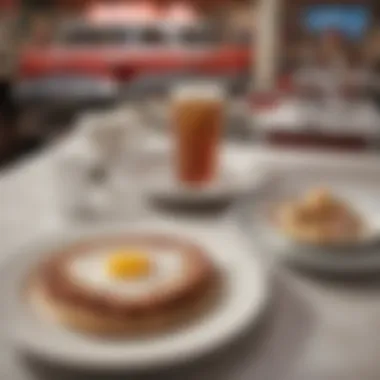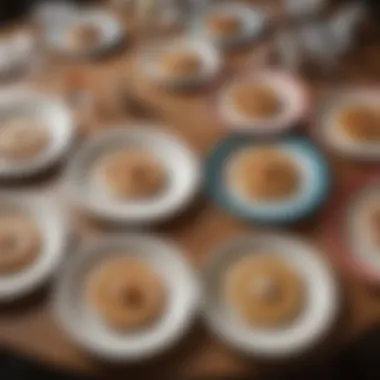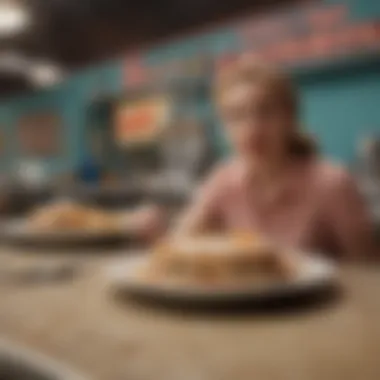The Cultural Impact of 50s Diner Plates in Dining


Intro
The world of 50s diner plates is more than just an artifact of retro dining; it encapsulates a specific time in American history when diners were a cultural fixture. Beyond the simplistic function of holding food, these plates served as a canvas for the design sensibilities of an era marked by post-war optimism and a burgeoning middle class. With their vibrant colors, bold patterns, and surprisingly durable materials, they not only nourished the body but also fed the soul with a hearty dose of nostalgia.
In this article, we will navigate the intricate layers that make up the significance of these plates. From their birth in diner kitchens filled with sizzling grills and the laughter of friends and family, to their resurgence in modern culinary practices, diner plates are a beloved staple that endures the test of time. Join us on this journey as we unfold the story behind these charming dishes, analyzing how they connect our culinary past to present-day dining experiences.
Prologue to 50s Diner Plates
The 50s diner plates are not just mere carriers of food; they are a tangible slice of Americana, recalling a time when diners were cultural hotspots. These plates serve as a reflection of the era's creativity and simplicity in design, showcasing an aesthetic that resonates with many even today. In today’s fast-paced world, the allure of these pieces remains. Their significance is multi-faceted, capturing nostalgia while serving a practical purpose in contemporary dining experiences.
Contextualizing the 50s Diner Culture
To understand the status of diner plates, it’s prudent to first grasp the culture that birthed them. The 1950s in the United States marked an era characterized by post-war optimism, economic growth, and a burgeoning fascination with consumer culture. Diners sprouted in cities and towns, offering a welcoming space for families and friends. They became communal hubs, where stories were shared over milkshakes and burgers.
In this vibrant setting, plates became more than just utensils; they were emblematic of social gatherings and the simple joys of life. Made from durable materials, diner plates were designed to withstand the rigors of daily use, yet they also carried a flair that epitomized the cheerful spirit of the decade. The importance of this cultural backdrop helps to appreciate fully the allure of diner plates, which have become collectibles and nostalgic artifacts.
Overview of Design Aesthetics
The design aesthetics of 50s diner plates is a study in contrasts—especially vibrant colors against a promise of durability. These plates often feature bold patterns, ranging from playful checkers to abstract designs that seemed to dance on the table. Colors like turquoise, cherry red, and sunny yellow were not just mere choices; they shouted joy and life, aligning perfectly with the diner’s lively atmosphere.
Notably, the shape of these plates is another significant aspect that draws interest. Many were round or slightly oval with smooth edges, aimed at creating a user-friendly dining experience. As diners strived for efficiency while serving, the sizing remained conducive to a variety of diner dishes.
As such, the aesthetic design choices that defined 50s diner plates are crucial. They embody an artistic expression reflective of their times, merging function with visually striking elements that spurred a wave of nostalgia in diners for decades to come.
"Diner plates are more than just dishware; they are a mosaic of memory and culture, epitomizing the simplicity and charm of mid-century America."
In summary, the exploration of 50s diner plates leads us deep into an era that shaped American dining culture. It highlights not just their functional aspects but also how they touched people’s lives and reflected a society that valued togetherness and joy.
Historical Background
Understanding the historical background of 50s diner plates provides vital insight into their cultural significance and the aesthetic choices that define them. This context enhances our appreciation for these plates, transforming them from mere kitchenware to cherished artifacts of a bygone era. At their core, diner plates not only served food but also represented a social development in American dining culture, where convenience and style intermingled amidst the rapid changes in society during the 20th century.
The Birth of Diner Culture
The birth of diner culture can be traced back to the Great Depression and post-war America. In the 1930s, people sought affordable yet enjoyable meals outside the home, leading to the emergence of diners as a popular solution. These establishments were more than places to eat; they embodied a sense of community and casual interaction.
Diners, initially converted from railroad cars, boomed in the 1950s, coinciding with the rise of automobile culture. The convenience of drive-ins and the allure of 24/7 operation drew in crowds. Plates used in these venues needed to be both functional and appealing to align with the cheerful and free-spirited atmosphere diners aimed to create. As such, the first diner plates, often featuring vibrant colors and kitschy designs, became emblematic of this lively culture.
"Diner plates were a canvas for creativity, showcasing the flavors of American life through their colors and patterns."
Material Composition of Plates
The material composition of 50s diner plates played a pivotal role in their functionality and appeal. Most diner plates from this era were made from a variety of materials, but ceramic and melamine held the spotlight. Ceramic was preferred for its durability and ease of cleaning, important for the bustling environment of a diner. Often, ceramic plates were adorned with intricate designs that reflected the vibrant culture of the time.
Melamine, on the other hand, gained traction due to its resilience. This plastic composite was both lightweight and virtually unbreakable, making it an ideal choice for diners where accidents were frequent. Its availability in bright colors made it a favorite in diners looking to evoke a cheerful ambiance.
The combination of practicality and aesthetic appeal in these materials contributed to the plates' significance. As diners flourished, the demands on their dishware called for innovation in materials that could withstand the rigors of daily use while still embodying the spirit of the time.
By diving into these histories, readers not only grasp the artistry behind these plates but also recognize their pivotal role in the tale of American dining.
Design Characteristics
The design characteristics of 50s diner plates are not just about aesthetics; they reflect a deeper narrative about the cultural zeitgeist of the era. Each element—be it the patterns, colors, or the shapes—speaks volumes about the American dining experience during the mid-20th century. These plates serve as a canvas, showcasing the artistry and innovation of a time when dining went beyond sustenance and ventured into a realm of experience and style.


Patterns and Color Schemes
Dive into the world of 50s diner plates, and you’ll quickly notice the vibrant patterns and color schemes that were all the rage. Bold stripes, polka dots, and whimsical scenes—these motifs were meant to evoke a sense of joy and playfulness, a stark contrast to the utilitarian designs of the past.
The colors used were often bright and engaging, including shades like cherry red, aqua blue, and sunny yellow. These choices were no accident. The lively hues not only caught the eye but also served to enhance the overall dining experience, making meals feel like festive occasions.
The combination of colors and patterns played a significant role in setting the ambiance of diners, creating an inviting atmosphere. In addition, the variations within patterns allowed diners to express individuality; no two plates were exactly alike, showcasing a mix of artistry. This creativity lent each meal a sense of character, transforming even simple fare into something remarkable.
"Patterns and colors from the 50s have an infinite ability to evoke a sense of nostalgia and cheer, making every bite feel like a step back in time."
Shape and Size Variations
When you look closer, the shape and size of 50s diner plates reveal more than just their functionality. These plates were typically round, perfectly suited for the diner’s signature dishes. The sizes often varied by department, with individual plates designed specifically for burgers, fries, or milkshakes.
Smaller plates might have been used for appetizers or desserts, while larger ones catered to heartier meals. This variety in size and shape is crucial; it catered to different dining needs, allowing chefs to present dishes in an organized and visually appealing manner.
Moreover, some plates featured unique shapes, like square or oval designs, which added a modern twist to traditional dining ware. These innovative shapes helped diners feel as if they were part of a greater culinary shift, embracing new ideas while still holding on to classic comfort.
Craftsmanship and Production
The artistry behind 50s diner plates is not just a matter of style; it’s about the painstaking craftsmanship that goes into their manufacturing. Each plate is a tangible embodiment of a specific era, showcasing not just a vibrancy in colors but also a particular finesse in design that reflects the societal values of the 1950s. Understanding the various elements of craftsmanship and production helps one appreciate these iconic plates beyond their aesthetic appeal, prompting a deeper respect for their historical context and enduring legacy.
Manufacturing Techniques
In the world of plate manufacturing, techniques evolve, though the essence of retro diner plates remains firmly rooted in traditional practices.
- Material Choice: Most diner plates are made from materials like melamine or ceramic. Melamine offers durability while retaining a lightweight quality. Ceramic, on the other hand, gives off that old-world charm with its sometimes intricate hand-painted designs. Different materials lead to distinct finishes and textures that collectors often obsess over.
- Glazing Process: A crucial step that defines diner plates is the glazing process. This involves applying a protective layer that can hold up against the rigors of daily use while also adding that nostalgic glossy finish. It’s not merely functional; the glaze often incorporates colors that resonate fondly with diners of yesteryears, like cherry red or sunny yellow.
- Decal Application: To achieve those eye-catching patterns, manufacturers frequently employ decals. This method allows for a variety of designs, from whimsical patterns to those depicting classic diner fare. The way these decals are applied and subsequently sealed is a testament to the artistry behind these plates.
- Firing Techniques: Post-application, plates are often fired in kilns at high temperatures. This not only solidifies the materials but infuses the colors, making them vibrant and resistant to fading. The firing times and temperatures can differ based on the desired finish, skillfully demonstrating the attention to detail that characterizes quality diner plate production.
Notable Manufacturers
Over the years, several manufacturers have distinguished themselves in the realm of diner plate production.
- Pennsylvania China: Known for its sturdy plates that became a staple in diners, Pennsylvania China embraced traditional techniques while also catering to modern tastes.
- Scio Pottery: This manufacturer gained fame for its unique designs and high-quality materials. Scio's plates often showcase vibrant colors and imaginative themes, drawing heavily from the 1950s aesthetic.
- Violet Dinerware: An up-and-coming player in the industry, Violet Dinerware focuses on recreating the classic styles with a fresh twist, appealing especially to collectors who cherish authenticity.
"Diner plates are more than mere dinnerware; they represent a melting pot of culture, style, and culinary history forged through refined craftsmanship."
By understanding these manufacturing techniques and the notable players in the industry, enthusiasts can appreciate the rich tapestry of creativity and engineering that these diner plates symbolize. Their production is a blend of art and practicality, making every plate not just a piece of dinnerware but a slice of Americana.
Cultural Significance
Understanding the cultural importance of 50s diner plates unveils layers of meaning that go beyond mere functionality. These plates are not just tools for serving food; they encapsulate a vibrant slice of American history, reflecting societal norms and lifestyle choices from an era that continues to resonate today.
Representation of American Identity
The 1950s marked a pivotal period in American culture, characterized by prosperity following the war and an increasing push for consumerism. Diner plates from this era serve as symbols of that identity. Designed often with bold colors and playful patterns, they exude a sense of optimism that was prevalent in post-war America.
These plates can remind one of family gatherings over hearty meals, where burgers and milkshakes were shared across shiny, chrome-plated tables. It was not just about the food; it’s about creating an atmosphere infused with joy and togetherness. Plates adorned with vibrant designs showcase not only the culinary delights but also the burgeoning spirit of innovation that defined the decade. This art was heavily influenced by both American culture and the aesthetics of the time, from the rise of fast food to jukebox music.
Moreover, the diner scene became a melting pot of various American subcultures, offering a menu enriched by diverse influences. The culinary craftsmanship reflected on those plates mirrored the very fabric of the nation - folks from different backgrounds enjoying a hamburger side by side. In this way, 50s diner plates are more than artifacts; they are conduits of shared experience, speaking volumes about American identity and unity.
Nostalgia and Its Impact
When we look back at 50s diner plates, a wave of nostalgia often washes over us. This nostalgia isn't merely sentimental; it plays a significant role in contemporary culture. Items from the past trigger memories of simpler times, evoking feelings of comfort and happiness. Nostalgia, as a cultural phenomenon, is powerful; it shapes how we perceive our present and even our future.
Diner plates become a cherished piece of history, as many recognize them as symbols of warmth and familiarity. These plates have a way of bringing back memories of family dinners, late-night outings with friends, or even that first date at a local diner. They signify not just the food but the whole experience around it, the laughter shared, and the connections made.


- That feeling of nostalgia serves as a bridge to connect generations. It allows younger crowds to feel a piece of their grandparents' lives, showcasing values that remain integral today, such as togetherness and simplicity.
- On a societal level, this nostalgic pull has led to a resurgence in retro aesthetics—think neon lights and chrome accents in modern eateries. Consumers now crave experiences that evoke the past while providing a twist of modern flair.
In the end, these diner plates invite us to take a seat at the table, reminding us that our culinary heritage is intertwined with our cultural identity. The delicious fare served on them is tied not only to nutrition but also to emotional connection, making them significant artifacts in an ongoing story.
Integration into Contemporary Dining
The role of 50s diner plates in today’s dining experience offers a fascinating blend of nostalgia and modern culinary practices. In a world where culinary enthusiasts seek to elevate their meal presentation, these plates serve not just as functional dishware but also as a bridge connecting past culinary aesthetics with present-day dining trends. By incorporating vintage diner plates, consumers tap into a unique sense of history, adding personality and a touch of whimsy to their dining setups. There’s something undeniably charming about serving a gourmet meal on a plate that has seen countless burger and milkshake ensembles.
Utilizing Diner Plates at Home
Using 50s diner plates at home can transform everyday meals into special occasions. Whether you're serving a casual family dinner or hosting a themed get-together, these plates bring a flair that’s hard to overstate. Here are a few important considerations when integrating diner plates into your home dining:
- Versatility in Use: Diner plates are not limited to traditional diner fare. You can plate everything from homemade pasta dishes to elaborate desserts on these iconic pieces.
- Practical Durability: Many diner plates are made from sturdy materials, designed to withstand the rigors of busy diner services, making them practical for home use as well. This durability often translates into resistance against chipping and scratching, ensuring your plates last through many meals.
- Themed Dinners: Consider hosting a retro-themed diner night, serving 50s-style recipes alongside your vintage plateware. This thematic approach not only pleases the palate but also creates a fun atmosphere that invites conversation and memories.
Displaying Diner Plates as Decor
Diner plates can also shine outside the realm of dining, taking on a new role as decorative pieces in your home. Here are a few ways to showcase these charming relics:
- Wall Art: Create a gallery wall using diner plates. Arrange them in a visually pleasing way to capture attention, and choose a mix of colors and patterns for an eclectic touch.
- Shelf Displays: Place diner plates in open shelving units or cabinets. Their vibrant colors and unique designs can add lively accents to your kitchen or dining area.
- Table Centerpieces: Stack a few plates or use them as bases for candle arrangements to create eye-catching centerpieces. It's a wonderful way to keep nostalgia alive while enhancing aesthetic appeal.
"Incorporating 50s diner plates into contemporary dining is not just a nod to nostalgia; it’s an invitation to experience meals as they once were, combining style and substance in perfect harmony."
By exploring these avenues—both for practical use and as decor—diner plates transcend their original purpose. They become storytelling pieces that can spark conversations about the history of dining in America, bridging generational gaps and fostering a lasting appreciation for culinary arts.
Recipes Paired with Diner Plates
Understanding the connection between timeless recipes and the iconic diner plates is vital to exploring the full scope of 50s diner culture. Plates made during this era were not just functional pieces; they played a pivotal role in how food was presented and perceived in a diner setting. Each dish served on these plates tells a story, represents a time in American culinary history, and evokes a strong sense of nostalgia. This section intends to bridge the gap between the past and the present, emphasizing how to harmonize retro aesthetics with contemporary dining while keeping the spirit of the diner alive.
Classic Diner Dishes
When someone mentions diner food, images of hearty meals come to mind. Classic diner dishes often feature comfort food that warms the soul. Let’s examine some quintessential offerings that might have graced 50s diner plates:
- Burger and Fries: A typical diner sees patrons enjoying a juicy cheeseburger, typically served with a side of crispy golden fries. The combination symbolizes an essential part of American fast food culture.
- Meatloaf: Simple yet satisfying, meatloaf tends to be a crowded favorite. When placed on a vibrant diner plate, it’s often garnished with mashed potatoes and gravy, presenting a visually pleasing meal.
- Breakfast Specials: Think of a hearty plate of eggs, bacon, and pancakes drenched in syrup. Served on a divided diner plate, this meal exemplifies what's often referred to as the most important meal of the day.
These dishes are commonplace in diners, but what makes them significant is not just their ingredients but the experience that accompanies each meal, from the bustling atmosphere to the plates that hold these culinary delights.
Modern Adaptations of Retro Recipes
Today's culinary landscape combines tradition with innovation, and adapting classic diner recipes allows us to embrace both realms. Modern creatives in the kitchen are reimagining these cherished dishes while maintaining their nostalgic essence. Here’s how:
- Gourmet Burgers: While traditional hamburgers are classic, many modern interpretations introduce unique flavors, like blue cheese and spicy aioli, showcasing culinary innovation while still appealing to diners' nostalgia.
- Health-Conscious Meatloaf: Contemporary diets encourage healthier ingredients. Modern meatloaf may use ground turkey or vegetarian substitutes, reducing calories without sacrificing flavor, yet still, the heart of the dish remains unchanged.
- Vegan Breakfast: As dietary preferences evolve, many diners today feature vegan pancakes and 'bacon’ made from plant-based sources. These adaptations ensure that the spirit of diner breakfasts can be enjoyed by everyone.
"Food is a universal language. It speaks the traditions of the past while reaching into the realm of modern tastes and preferences."
By pairing these delicious meals with 50s diner plates, one can evoke that sense of nostalgia while enjoying contemporary culinary artistry. The plates themselves become a canvas, enhancing the experience for diners of all ages, keeping the legacy of 50s dining alive.
Collecting 50s Diner Plates
Collecting 50s diner plates goes beyond mere nostalgia; it's about celebrating a significant piece of American culture. Each plate tells a story, carrying echoes of diners filled with the hum of conversations and the clatter of silverware. Collectors often find themselves diving into the rich history of these plates, uncovering stories that span decades. This journey not only enriches their understanding of mid-century dining aesthetics but also brings a slice of history into their homes.
One of the most compelling reasons for collecting these plates is their craftsmanship. Many diner plates were made with a commitment to durability and design, utilizing materials that shaped the diner experience. For those who appreciate art and functionality, these plates merge both. But there’s more to it.
Certain collectors are drawn to the thrill of the hunt, scouring flea markets, antique stores, and online auctions. This treasure-seeking offers a unique kind of satisfaction, each find representing a piece of the past, often at affordable prices. Moreover, as the popularity of vintage aesthetics rises, having authentic diner plates can serve not just as a conversation starter, but also as an aesthetic choice in home dining and decor.


Finding Authentic Pieces
When on the lookout for authentic 50s diner plates, it’s essential to arm yourself with knowledge. Recognizing the features of genuine diner plates—such as weight, style, and backstamps—can greatly increase your chances of acquiring the real deal. Common types include the sturdy melamine options that were popular for their durability, or china dishes decorated with classic diner patterns.
To get started, make use of the following tips:
- Research the Brands: Get familiar with famous manufacturers such as Homer Laughlin or Shenango, known for their diner ware.
- Check Online Marketplaces: Websites like eBay and Etsy often list vintage diner plates. Look for sellers with good reviews.
- Attend Vintage Fairs: Events focused on antiques typically have collectibles, and you might just strike gold.
Ensuring you’re getting authentic pieces can save you from the distress of spending on replicas that lack the charm and history of genuine diner plates.
Preservation Techniques
Once you've started your collection, the next step is to care for those plates so they endure for years to come. Over time, even the most durable diner plates can show wear if not maintained properly. Here are some key preservation techniques to keep your pieces in tip-top condition:
- Gentle Cleaning: Opt for a mild detergent and soft sponge. Avoid abrasive cleaning products that may scratch the surface.
- Storage: Store plates upright in a cushioned space. Consider using foam dividers to prevent scratches.
- Temperature Considerations: Keep them away from extreme heat. Sudden temperature changes can be detrimental; think of a cold plate going into a hot oven, for instance.
"Every plate has a past that deserves to be remembered. Proper care ensures that these stories stay alive for future generations."
By investing in both authentic plates and their preservation, collectors not only acquire a piece of history but also set the stage for future culinary experiences that blend the past with contemporary dining.
Future Trends in Diner Plate Design
As we embrace the future of dining, it’s essential to take a look at the evolving world of diner plate design. The importance of understanding contemporary trends cannot be understated, as they not only reflect shifts in aesthetic values but also adapt to modern culinary practices and consumer preferences. In this section, we will discuss elements that are reshaping diner plates today, benefits they bring, and the considerations one must keep in mind.
Evolving Aesthetics
Diner plates of the 50s exuded a unique charm with their vibrant colors and playful patterns, but as we glide into the modern era, there are notable shifts in aesthetics. The classic diner plate, now, is seeing a resurgence of retro flair complemented by minimalist designs. Think of sleek lines, softer hues, and even the introduction of earthy tones which reflect a broader shift in food presentation. Plates are not just vessels anymore; they are canvases.
Innovations in materials have also contributed to these changes. While the traditional ceramic remains popular, more sustainable options like bamboo fiber and melamine are gaining traction. This shift towards eco-friendly materials speaks volumes about consumer awareness and responsibility.
"In today's culinary landscape, a plate can tell a story. It isn’t merely about what sits upon it; it’s about the entire dining experience."
When it comes to shapes, expect to see more asymmetrical designs and unusual contours, which echo the experimentation happening in kitchens far and wide. These designs not only make a statement but also enhance the dining experience by engaging your senses in new ways.
Influences from Modern Culinary Arts
An exciting aspect of diner plate design is its interaction with modern culinary arts. When chefs prepare dishes, they're often thinking beyond taste, focusing on the visuals as well. This aspect is crucial as we see food plated more artistically than ever before. A beautifully crafted plate enhances the presentation of the dish, creating a complete sensory experience that diners remember long after the meal is over.
Today, social media plays an enormous role in how dishes and their corresponding dinnerware are perceived. Platforms like Instagram and Pinterest have created trends where the culinary world takes cues from fashion and art. Vibrant plates can elevate the entire dining experience, prompting chefs to design dishes that pop against colorful or uniquely shaped plates.
Moreover, fusion cuisine—a blend of different cultural elements—encourages diversity in plate designs. Set either for a classic burger or a colorful poke bowl, plates are becoming more versatile to cater to a plethora of dining styles.
Epilogue
The exploration of 50s diner plates reveals a significant facet of American culture, emphasizing not only their aesthetic appeal but also their deeper meanings and connection to nostalgia. As we reflect on the journey of these plates, it becomes evident that they serve as more than just functional dinnerware; they encapsulate a time when diners were the heart and soul of community dining, a place where people gathered over hearty meals, often served with a side of friendly banter.
Reflecting on the Journey of Diner Plates
The evolution of diner plates is a rich narrative that intertwines with shifts in American dining habits and societal changes. These plates tell tales that are as varied as the food they hold. Born out of necessity during a time of post-war optimism, 50s diner plates quickly became emblematic of an era marked by vibrant colors and bold designs. Enthusiasts today often seek these plates not merely for their nostalgic value but for the stories they represent.
The materials and craftsmanship speak volumes about the culture from which they arose. For instance, the use of durable china and unique finishes reflect an age of innovation in both design and manufacturing processes. Collectors often take pride in sharing these backstories with others, revealing how a simple plate might possess a line of heritage that nods to the craft and care of its original makers.
In essence, diner plates are time capsules; even the smallest chips and scratches tell a story of meals shared and memories forged.
The Timeless Allure of Diner Aesthetics
Diner plate aesthetics transcend the mere visual appeal; they evoke a sense of warmth and nostalgia that is hard to replicate. With their playful patterns and sturdy builds, these plates summon images of bustling diners filled with laughter, the hiss of the grill, and the clattering of cutlery. The curvilinear designs and vibrant glaze often showcase artistic expressions that are downright charming yet practical.
- Bright colors like turquoise and pink create an inviting environment, perfectly suited for the idealized American dream of the 1950s.
- Patterns, such as checkered edges and polka dots, accentuate a playful dining experience and celebrate the joyous spirit of the era.
People today integrate diner plates into modern dining settings, lending a retro flair to contemporary dishes. Whether it's a gourmet burger or a craft salad, these plates serve as a reminder that food is best enjoyed in good company. Ultimately, the lasting allure of diner plates lies in their unique ability to marry nostalgia with everyday life, creating a dining experience that resonates with generations.















